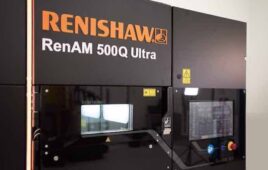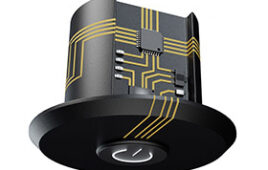When Siemens added generative design capabilities into its Solid Edge 3D CAD modeling system in 2017, it opened the door for engineers to design optimal parts that meet all their specifications faster than ever before.
Generative design turns the traditional design approach on its ear and, in doing so, reduces part costs—often by reducing part weight–speeds product time to market, creates single-body parts and parts in organic shapes that couldn’t be designed or manufactured in the past. Parts with curved lines and with shapes taken from nature, shapes that twist and bend, and that can be printed with 3D printing after they’ve been designed with the generative process. These unique pieces with attractive appearance stand out from the competition. Innovative products at the click of a button! (Design World is hosting a Generate Ideas Component Design Contest that you can enter. Let us know about your toughest component design problem and how you think Siemens Generative Design software could help you tackle it. You can find out more details about the competition here and at the end of the article.)

Generative Design turns the traditional design approach on its ear, reducing part costs—often by reducing part weight. It also speeds product time to market, creates single-body parts and parts in organic shapes that couldn’t be designed or manufactured in the past. Parts with shapes taken from nature can be printed with 3D printing after they’ve been designed with the generative process.

Perhaps you’ve heard some rumblings about generative design though you’re not sure exactly what it is, how it differs from a traditional design approach, or why more companies are investigating this new design method. With it, engineers can design an optimal solution without using multiple CAD operations. And they can evaluate hundreds of viable options rather than a single design.
The generative technique is a completely different approach to design. By calling upon advanced software and computing power the system runs through many possibilities based on the engineers’ design specifications and then presents the optimized design to the engineer. Engineers are involved at the beginning and at the end of the design process. If they don’t feel any of the returned designs meet their standards, they can adjust inputs such as the targeted decrease in weight of the component, and cue the generative-design system to start again.

Hall 3D printed a sample part in aluminum and found it strong enough to be used as a gas pedal in the customer’s vehicle racecar.
Here’s a close-up look at how engineers use generative design: Using a single ribbon on the Solid Edge user interface, engineers define a component’s material, the features critical for the simulation, and other forces and physical phenomena that will act upon the model. They also set constraints for the design areas that can be reshaped as the generative system runs through design possibilities, areas that are off limits, and areas where specific geometry such as load bearing surfaces or pivot points are required.

Plugging pedal specs into Solid Edge’s generative design tool, including the instructions for the part to be made from a single-piece assembly, resulted in the program delivering this solution.

From there, engineers press go. Solid Edge’s generative design software automatically generates design alternatives that meet all the engineering inputs.
The engineer can also choose how long the design tool will run. The longer a simulation runs, the higher quality the results.
Behind the scenes, the software is using an approach called topology optimization, which uses finite element methods to analyze hundreds of potential design solutions. It finds and then presents the best of the bunch—the most optimized models based on inputs—to the engineer.
Not Going Away
While the process takes advantage of advanced software and computing power to optimize designs, engineers are still vital to the process. As we’ve seen, they need to understand design requirements, set design criteria, and go through the returned designs comparing optimized models in order to select the design that best meets their needs. While generative design software narrows the field, the engineer controls the final decision. After viewing results, engineers may find they need to modify their inputs and run another generative design study.
It’s important to know that the 3D CAD models returned through generative design use a mesh based 3D geometry representation, in which mesh that looks like a net made of flat triangles defines the model. The stereolithography method that 3D printers call upon to print parts uses the mesh method. So do the handheld or large instruments that scan a part to be reverse engineered. That method allows for the curved, shapely parts that don’t follow typical geometrical lines. But most current CAD systems use boundary representation, or B-rep, models, which serve as an exact mathematical model of a 3D part.

The creation from Solid Edge Generative Design tool is a single-piece assembly that is lighter than the original. Hall saw that the organic shape would have led to costly machine work to create it in the usual way, but he was using the generative approach with the goal of 3D printing.

Solid Edge allows you to combine mesh and B-rep models in one environment using Siemens convergent modeling technology. Engineers can use standard Solid Edge commands to add features to these mesh models such as cut outs, holes, or bosses to generatively designed models. The meshed results are integrated into the normal model-editing process so engineers can further optimize components and add specifc features. Also, generative models can be placed in assemblies side by side with B-rep models and be placed onto drawing sheets.
Generative design is set to change the way engineering organizations work; the way engineers work. Individual engineers may eventually look like managers, only they’d be managing many software agents. They’d hand out tasks such as “go explore this design and then generate a number of alternatives.” Engineers may have four to ten of these design tasks running simultaneously while they’re spending their time meeting with customers or suppliers, or doing any of the other myriad jobs engineers carry out in the course of the day. And when they return to their computer, they’d have many design alternatives waiting to be reviewed. In this way, generative design gives engineers more time, freeing up time traditionally spent modeling.
Opportunities Generative Design offers for manufacturing companies
For manufacturing and engineering organizations, generative design holds the potential to cut the cost per part. It can, for instance, reduce the amount of material the part uses. This is because topology optimization running behind the scenes uses the finite element analysis method to break the component into tetrahedrons and runs analyses on those tiny elements. In this way, it finds small and large areas within the design that contain more material than needed.
Reducing the amount of material a part is made from is of particular importance to manufacturers that make parts in high volume, though the benefits can also apply to makers who use batch production or one-off parts. Less material in the original design means minimal downstream manufacturing material waste.

The generative technique is a completely different approach to design. By calling upon advanced software and computing power the system runs through many possibilities based on the engineers’ design specifications and then presents the optimized design to the engineer. Engineers are involved at the beginning and at the end of the design process. If they don’t feel any of the returned designs meet their standards, they can adjust inputs such as the targeted decrease in weight of the component, and cue the generative-design system to start again.
Efficiency and energy consumption gains are seen when lighter-than-usual components are used for moving machine components. And of course when it comes to vehicles and airplanes, lighter components reduce energy consumption, which of course comes with environmental benefit. And those lightweight components also allow some manufacturers to meet regulatory requirements for the efficiency of their products.
Another way generative design reduces manufacturing costs: the generative process results in a single, solid-mesh body that can replace multibody components, such as a welded assembly. This reduces a manufacturer’s need to spend money on jigs, fixtures, welders, and welding material. And single-body parts can be made via additive manufacturing, also called 3D printing, which also reduces the need to design and manufacture tooling.
Pedal to the Metal
To see how generative design saves time and money while offering customers and consumers a wow factor, take the case of Hall Designs, which designs racecar components. Hall Designs began using Solid Edge generative design as a beta tester late last spring, says Craig Hall, company owner.

Traditionally, a gas pedal often consists of five or six different parts welded together. In this example from Hall Designs, a race car components designer, two of those were machined pieces and the others were laser cut sheet-metal pieces welded together.
“I was just kind of playing around with it,” Hall says, “and then it took off and evolved into making an actual part for a customer.”
Up to that point, the part, a gas pedal, had been traditionally manufactured. “Just a steel part, laser cut and bent, with machined pieces that had to be welded together,” in Hall’s words.
The steel gas pedal was made from five or six different parts welded together, two of those were machined pieces and the others were laser sheet-metal pieces also welded together.
He plugged pedal specs into Solid Edge’s generative design tool, including the instructions for the part to be made from a single-piece assembly. Not only did the generative tool return a design for a single-piece assembly that met all Hall’s needs, that design was for a piece lighter than the original, too, because Hall had told the tool to reduce the weight of the steel gas pedal. Hall Designs knew the part would be made via the 3D printing process and was pleased by the shapes that generative design returned.
“That organic shape would have led to costly machine work to create it in the usual way,” Hall says. “I was using generative with the goal of 3D printing. From the beginning, we knew generative would save us weight and give a unique look to the part and separate itself from parts we’ve made in the past.”
Hall 3D printed a sample part in aluminum and found it strong enough to be used as a gas pedal in the customer’s vehicle racecar.
“We haven’t raced with it yet, but it’s a fully functional piece,” Hall says.
He’ll continue to use Solid Edge’s generative design tool.
“I spend my time taking customer parts and coming up with a generative shape as an option for them. When I have a lot of components on a piece, that’s when I’d really like to try to replace it, whether it be with a metal printed, or even a plastic-printed part.”
All this with this new generative design technique. Engineers rejoice.
Siemens PLM
www.plm.automation.siemens.com/global/en/
Here’s an infographic that illustrates the differences between traditional CAD design and Generative Design.



— What’s your most interesting design idea?
Let us know about your toughest component design problem and how Generative Design could help you tackle it—for a chance to win software and a 3D printer!
CAD programs continue to evolve to meet the needs of industry, incorporating the ever-increasing computational power available to design engineers. From their humble beginnings, these programs have added helpful design tools such as FEA and CFD. Today, the groundbreaking new design tool is topology optimization.
Design World is offering readers an opportunity to explore the possibilities of this type of program with their greatest component or product design challenge. Readers are invited to submit their design idea, with images, to be judged on feasibility, innovative potential and creativity. In 500 words or less, please describe in detail the problem/challenge for designing a specific component or product. Also explain why it’s important and/or how you would use the generative design approach together with 3D printing technology to design and manufacture the component or product.
If possible, include images (in jpeg format). Submissions are due by February 28.
Topology optimization programs use algorithms to optimize material layout and designed component performance within set spatial dimensions. Engineers use topology optimization software, like Siemens Solid Edge Generative Design, to handle applications in aerospace, medical, industrial equipment, and even consumer areas. These optimized designs cost less to make in material usage, time, and manufacturing assembly than designs made through traditional design and manufacturing approaches, and they often result in significant weight savings. The winner will receive one year’s usage license of Solid Edge Premium plus Solid Edge Generative Design Pro, as well as a desktop 3D printer from BeeVeryCreative to realize their vision. BEETHEFIRST+ is an easy-to-use, plug & play, multi-material and portable 3D printer, specially designed for professionals.
Winner will be announced March 9. Click here to enter.
Filed Under: 3D printing • additive • stereolithography





Tell Us What You Think!